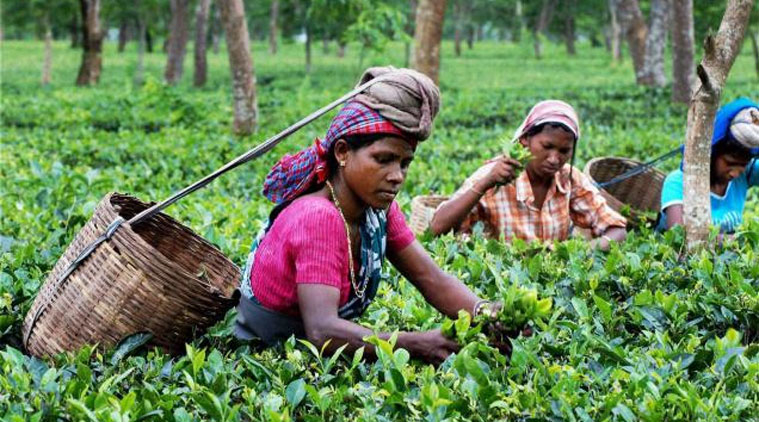The Chai Waahli and systematic discourse
Posted on October 26, 2018Chai Waahli is Hindi for a female tea merchant.
Chai to us Indians is a serious affair. Over a cup of tea, gossip is shared, fights are resolved and the country’s most important decisions are made. It is a harmonious blend of black tea leaves brewed in water with milk, laced with the flavour of aromatic spices (cardamom, cinnamon, cloves), ginger and often mint and lemongrass as well. Woven intricately into our everyday, it represents several facets of our history and society. Though there is no linear method of mapping how tea relates to culture, it might be useful to look at of the relationship it has with women.
As much as chai is loved as an integral part of our way of life, it owes its origins to a dark past. It was not until the advent of the British that black tea, an essential component, became a part of the concoction as we know it. They established several tea estates in Assam, staffing them with slaves until slavery was banned, and then with several ill-treated labourers [1]. Since the British rule ended in 1947, not much has changed on the tea estates. A recent report by the British charity Traidcraft Exchange found that the estate workers are paid less that $2 a day [2]. What has changed though, is the demographic of the workers. Most tea pickers are now tribal women as they traditionally accept low wages and are servile in nature. Additionally, the tea picking is not mechanised, requires a lot of patience and not too much strength – all qualities regularly associated with women [3].

Tea estate workers are mostly tribal women | Image courtesy: Indian Express
If a map be made of the changing demographic involved in harvesting tea, it would emerge that a certain body of power is exploiting the less powerful in the area. What the British did to the Indians, the non tribal Indians (mostly men) now do to tribal women. Though the participants in the system have changed, two things emerge (a) there remains a consistent behaviour pattern over time, indicative of a feedback loop [4], and (b) power, here in the form of gendered and urban privilege, self organises systems [5].
In a slightly more benefitted scenario, lets look at arranged marriages in middle class India and what it has to do with tea. Stereotypically, the potential bride makes tea for the potential groom and his family the first time they meet – it helps break the ice and start a conversation. It is also indicative of the domestic nature desired in a potential housewife. In an article for the New York Times, Lizette Alvarez interviews an Indian woman,
“Ms. Sapra had attended 10 of the more formal arranged meetings — awkward, drawn-out affairs in which the young man, his mother and several other relatives came over to meet the young woman and her family. She wore her best Indian outfit, a sari or elegant Indian pants and top. She sat quietly, which is almost impossible to fathom, considering her chattiness. When called upon, she poured tea, and then talked briefly to her potential mate in a side room.
”The matriarchs do the talking,” she said over a glass of wine at an Italian restaurant. ”You sit there looking cute and like the ideal housewife.”[6]
The tea-making does not end there. Almost all married lower and middle classed women set a pot of tea to brew as one of the first things they do in the morning. An accurate depiction is in Gauri Shinde’s acclaimed film, ‘English Vinglish’. Sridevi’s character, Shashi is introduced as she goes about her chores in the kitchen in the morning. Just as she sits down with a newspaper and her own cup of tea, her husband Satish hollers for his morning tea, and she puts her own cuppa aside (to make his) [7].

Advertisement for Brooke Bond Red Label Tea | Image Courtesy: Light House Insights
Corresponding to these stereotypes, the designed world becomes gendered. It is important to enquire into what is made available to women in the market and its influence on the female viewpoint. From the little academic writing done on consumption with regard to feminine taste, social scientists have recognised it as a means of social organisation, along with realising that feminine taste and consumption often function outside the values and judgements imposed on it by masculine culture [8]. Objects, like humans, have different meanings and responses in different contexts. Design ingrains these notions in subtle yet powerful ways in everything that it touches [9]. They instigate a reinforcing loop in the system of doing gender. However, as Donella Meadows claims, systems have limited resilience [10]. There is only so much ‘gender’ that can be ‘done’ until the system begins to revise itself, evolve and emerge in protest.
Coming back to chai and women, the last and final example will address a further more privileged context. Brook Eddy, a resident of Boulder, Colarado, went to India to follow the Swadhyay movement where she first encountered chai. She fell in love with it – and thought to bring it to the US. In an interview with Una Morera of Inc., she says,
“I realized the recipe I had crafted for myself, a fiery fresh ginger chai, could be produced for cafés and retailers to bring people not only ‘India in a cup,’ but build a mission-driven company on the tenants of bhakti [11].”
Funnily enough, she named her brand Bhakti, which is Sanskrit for devotion. Further, owing to the company’s original mission of creating a business that supported social change, she started a nonprofit, GITA an acronym for Give, Inspire and Take Action but also the name of a Holy Hindu text.

Brook Eddy was born in Colorado to hippie parents, but feels strongly connected to India | Image Courtesy : Inc.com
There are a few problems with the phrases the article uses. (a) India, or any other country/culture cannot be accommodated in a tea cup – especially when it is removed from its context, and consumed for it exotic nature. Also, just as much as we love our chai, it is not all that we are. (b) Appropriation and appreciation are not to be confused. Chai is significant to our culture, and as mentioned briefly above, it pays homage to our colonisation. Further, how Eddy has insensitively named her brand Bhakti and her nonprofit GITA is appropriating religious sentiments. (c) In the beginning of the article, Morera describes Eddy to be “America’s own 21st-century master chai wallah (Hindi for male chai merchant) [12].” Chai wallahs are tea merchants who occupy almost every other street in cities, towns and villages in India. As everyone needs a cup of tea, they develop a rapport with people from every walk of life. A cup of chai is less than a dime, and despite their popularity, chai wallahs struggle financially. It is not an easy title to live upto.
By now, you have figured that the discussion around tea and women addresses a much larger discourse than it actually seems. There are no systems in solidarity and linearity and there are several unknown factors that feed into them. There are several stocks and flows, and changing one would mean a change in the whole system. As Meadows says,
“Social systems are the external manifestations of cultural thinking patterns and profound human needs, emotions, strengths and weaknesses. Changing them is not as simple as “now all change”, or knowing that he who knows the good shall do the good [13].”
As practitioners of design, it is important how we deal with these systems that surround us everyday. What we might think as good, might affect negatively further along in the system and vice-versa. Alongside, we are all not one people – we come from different faiths, cultures and upbringings. Who do we design for?
While you ponder on the thought, I will go back to my chai, its getting cold now.
– H. M.
References
[1] : Rowlatt, Justin, “The dark history behind India and the UK’s favourite drink,” for BBC news, July 2016
[2] : Bannerji, Annie and Hussain, Zarir, “India tea workers live in ‘appalling’ conditions on $2 a day:report,” for Reuters, May 2018
[3] :Bhadra, Mita, “Gender dimensions of tea workers in West Bengal,”indian Anthropologist Vol. 34, 2004
[4] : Meadows , Donella , “Thinking in systems,” Earthscan London, 2009, p 25
[5] : Meadows , Donella , “Thinking in systems,” Earthscan London, 2009, p 81
[6] : Alvarez, Lizette, “Arranged marriages get a little rearranging,” for The New York Times, June 2003
[7] : Shinde, Gauri, “English Vinglish,” Hope Productions and Eros International, September 2012 [Film]
[8] : Sparke, Penny, “The Architect’s Wife, Introduction to As Long As it’s Pink: The Sexual Politics of Taste”, 1995 from The Design History Reader, Bloomsbury New York, 2010, p 355
[9] : Boehnert, Joanna and Onafura, Dimeji, “ Design as Symbolic Violence: Reproducing the ‘ism’s+A Framework for Allies,”School of Arts and Communication, Malmö University, November 2016
[10] : Meadows , Donella , “Thinking in systems,” Earthscan London, 2009, p 76
[11] : Morera, Una, “On a Whim, This Hippie Founder Packed Her Bags for India. Now, She’s Made $35 Million Selling Chai Tea, ” for Inc., 2018
[12] : Morera, Una, “On a Whim, This Hippie Founder Packed Her Bags for India. Now, She’s Made $35 Million Selling Chai Tea, ” for Inc., 2018
[13] : Meadows , Donella , “Thinking in systems,” Earthscan London, 2009, p 81